Introducing the latest myCWT product and service enhancements
Building on our digital, omnichannel myCWT platform, our new products and services will simplify travel management for you and your employees – anytime, anywhere, anyhow.
Note: Featured services may not be available in your country at this time. Please reach out to your CWT representative for more details.
Hear from Chief Product Officer, Erica Antony as she shares the key product highlights of 2024, along with the key areas driving innovation.
-

2040: Baseline, Boom or Bust
As we enter an era of rapid transformation and unprecedented challenges, it is essential for travel managers, meeting & event planners, and corporate decision-makers to look ahead and frame our current strategic thinking with a clear vision of the future. Business travel and meetings and events (M&E) are poised for significant change over the next decade and a half, driven by a complex interplay of sustainability goals, technological advancements, evolving work models, and geopolitical dynamics.
In this paper to mark the 10th anniversary of our Global Business Travel Forecast, we explore, for the first time, a long-term vision of the future and potential trajectories through three distinct scenarios, each offering insights into how these forces should affect policy-making, budgeting and priorities. By examining these scenarios, we can better understand the diverse possibilities that lie ahead and the strategic imperatives required to thrive in each potential future.
Based on trajectory data analysis and interviews with industry leaders, behaviorists and climate tech founders, this forward-looking approach enables us to anticipate changes, strengthen our strategies, and make informed decisions that align long-term objectives. It is through this lens of foresight and adaptability that we can build resilience, seize opportunities, and navigate the complexities of the future.
We invite you to reflect on the insights presented, and consider how your organization can prepare for the opportunities and challenges that lie ahead. Together we can ensure that travel and meetings remain catalysts for growth, scalability and sustainable practices.
- Scenario development is both an art and a science
- Megatrends Shaping the Future of Business Travel, Meetings and Events
- Sustainability goals the new crux of corporate policy
- Technology Revolutionizes Travel Management
- Modern work models spark new travel patterns
- Changing demographics open doors to new opportunities
- Three Scenarios: Base case, boom and bust
- Future-proofing strategies

-

CWT GBTA Global business travel forecast 2025
When it comes to pricing, global business travel has finally reached an enduring, higher baseline. Prices will continue to rise in 2025, but only moderately, so expect a period of normalized growth.
However, this pricing environment, one of marginal gains and price regularity, is fragile. Global leisure travel has now realized a lot of its pent-up demand, while corporate travel has been resurgent, with 2024 edging at preCovid levels.
There are many factors at play, whether its volatile oil prices, labor costs and constraints, inflationary pressures, and geopolitical factors. As this elevated baseline edges upwards, albeit marginally, travel budgets will come under increased scrutiny, especially as travel patterns and attitudes change.
It’s why business travel can’t be viewed in a silo, and the true value to an organization must be fully realized. This forecast can help with those calculations.

-

Capitalize on emerging technologies in corporate travel
Technological advancements are accelerating at an unprecedented pace. How will emerging innovations like Generative AI, blockchain, and self-sovereign identity (SSI) transform corporate travel?
BTN and CWT probed global CEOs, travel managers, industry consultants and tech experts on the promises, questions, and expectations these innovations raise and how they are set to reshape traveler experience, cost control and service delivery in corporate travel and events.
Download and discover
- The technologies that will have the greatest impact on corporate travel in the next 2-5 years
- How these emerging technologies are poised to control costs, enhance service and security, and boost efficiency
- The critical challenges, opportunities, risks and roadblocks each innovation raises
- What travel managers, buyers and experts anticipate from these innovations

-
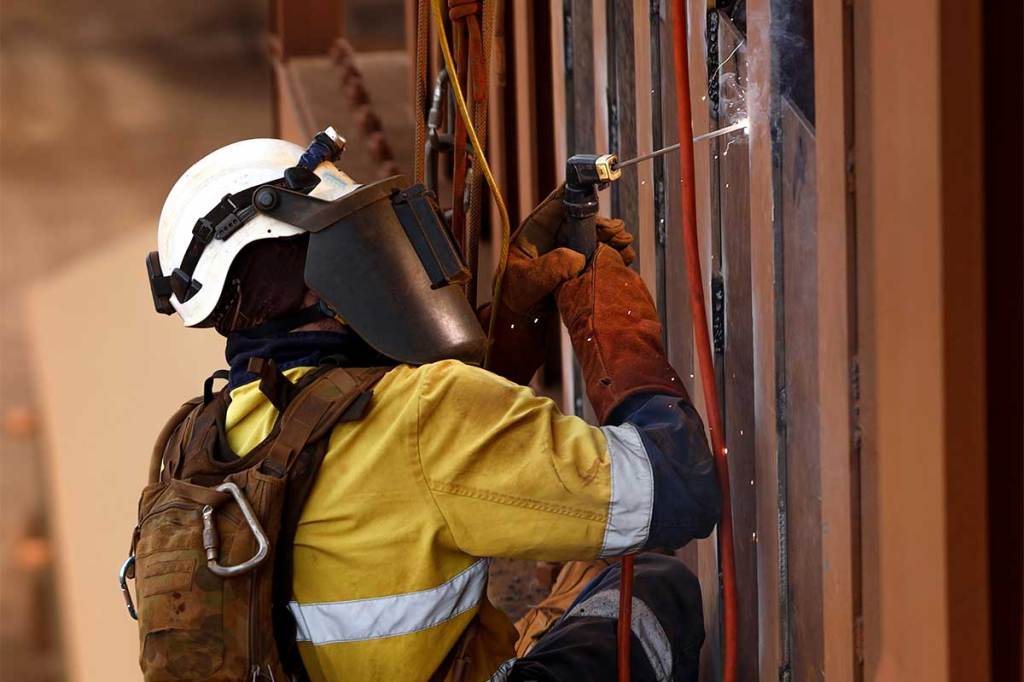
Energy source: How to prioritize well-being in some of the most challenging work environments
A report by CWT Energy, Resources and Marine (ERM) reveals that 52% of C-suite and senior executives say their organizations have traveler health and safety programs in place. While only 32% say their organizations measure and report on the impact of traveler well-being. It’s clear there’s progress to be made.
“There’s a heightened awareness of how we’re all trying to live more healthy, balanced lives.” Says Daniele Gabois, VP Global Business Development at CWT Energy, Resources and Marine.
In a sector like ERM, the well-being of travelers is critical.
“The energy, resources and marine industries have long been leaders in understanding and addressing health and safety for their traveling workforce, not least because of the complexities ERM travelers uniquely face en route to, and when they arrive at, their often-remote destinations,” says Raphaël Pasdeloup, Senior Vice President and Global Head of CWT ERM.
Fatigue-induced decision-making, while on a rig or inside a mine, could put a worker in harm’s way. How can companies and travel managers put their employees’ needs front and center? Here are steps to build an organizational culture that values and supports the well-being of travelers.
- Research – Survey your employees to understand how they are affected by travel-related issues like stress, fatigue, exercise and nutrition. Use this knowledge to get buy-in from leaders who make travel-related decisions.
- Implement – Define target interventions such as changes in the design of travel policies or adoption of new tools and services to support wellness while traveling. Meanwhile, actively promote wellness initiatives that relate to travel alongside other employee benefits.
- Monitor – Measure key workforce indicators such as program participation, employee turnover, employee satisfaction and engagement and healthcare claims.
Find out more about how to address the health, safety and wellbeing of travelers in the most demanding work environments in 2020 Vision: A Close look at the well-being of traveling employees.
Image credits: Adobe Stock
- Research – Survey your employees to understand how they are affected by travel-related issues like stress, fatigue, exercise and nutrition. Use this knowledge to get buy-in from leaders who make travel-related decisions.
-

Head start: How to finish the year strong
All’s well that ends well. It’s not how you start, it’s how you finish. Glory awaits you at the finish line; When facing the final month of the year, these old sayings aren’t always helpful. Some of us feel less like an Olympic sprinter and more like we’ve hit a runner’s wall.
The big existential questions come home to roost right at the time when we have a packed month of planning, performance reviews, projects to finish and family visits to plan.
What if we used the time usually spent getting trampled in pre-holiday sales to reflect and plan in peace? Here are three ways to wind down the year so you can start 2020 firing on all cylinders.
1. Think bigger picture
Everyone has a productivity tool or method that works for them, whether it’s an app, project management tool or good old-fashioned notebook.
Instead of the drab daily to-do list, try a method that uses positive psychology and and helps you develop habits that improve your life. Investigate bullet journaling or planners like the Best Self planner. They’re structured to help you achieve longer-term goals.
2. Make your gadgets work for you
Our phones are specifically designed to do one thing: grab our attention. You can configure your phone to do less of it. Use the settings to turn it from color to grayscale, set a night shift schedule and turn off notifications and ad tracking so you get fewer alerts.
Declutter your digital life by deleting apps you haven’t used in the last six months and unsubscribe to unwanted emails manually or with a site such as Unroll.me.
Install apps to streamline your life on the road such as a currency converter, translating apps and the myCWT travel management app.
3. Reflect well, resolve well
Several research firms cite a failure rate of at least 80% when it comes to New Year resolutions. Yet we still make them, often on-the-cuff when pressed by a fellow NYE party guest.
Are there alternatives to resolving to shed a quarter of your body weight by February and publish your first novel at the same time?
Replace the old resolution-setting with a new method. Identify a word of the year such as ‘clarity’ or ‘health’ and journal why the word is meaningful for you going forward. Stick it on a post-it note and consider the word when making choices. If you inspire yourself rather than set daunting tasks, you’re more likely to succeed.
Similarly, review the last year for signs of growth instead of singular moments of success. Did you become more assertive or better at negotiating? And how can you build on these skills going forward? After all, life’s a marathon, not a sprint.
Image credits: Adobe Stock
-

One direction: 3 ways to build company culture
It’s the final day of Culture Week at CWT. There have been lunches and learning sessions, community service and constant activity on our internal network ranging from a diversity and inclusion charter to votes for carbon-offsetting projects.
Under a six-word-story thread, a post from Christine stood out: “22 years, 12 years, growth and development.” Anyone who has seen David Brent’s character in mockumentary series ‘The Office’ knows, company culture is rarely middle-of-the-road. It’s either a car crash or it leads to statements like this one from Christine.
CWT has over 18,000 employees and over 90 nationalities. Like with all global companies, culture is harder to build than in a smaller outfit. But it’s just as critical.
According to Deloitte, 88% of employees believe a distinct workplace culture is important to business success while only 19% of executives believe their company has the ‘right’ culture.
“I’m reminded that what strengthens a culture isn’t a single program, meeting, survey, or celebration,” says Michelle Frymire, Executive VP and Chief Financial Officer, “These activities all have value to the business, but to accelerate performance through innovation, empowerment, and customer focus, we each need to make a personal connection. Because ultimately, people build culture.”
So how do you foster a positive company culture? Here are three ways.
1. Talk about your values
Make your company values clear to prospective hires. Ask interview questions based on your company values, put up posters in the office that promote them and be sure that on-boarding practices set clear expectations. Keep your values front and center on an ongoing basis by raising examples of them in action during team meetings.
2. Keep lines of communication open
The best way to degrade culture is to stop getting feedback from employees. Or worse – make them fearful of providing it.
“First and foremost, collaboration is about our people, but it is also enabled by technology and through both physical and online spaces.” says CWT’s Chief Traveler Experience Officer, Niklas Andreen,
Maintaining an open-door policy helps your business stay grounded. Encourage opportunities to share experience through formal channels like an anonymous employee pulse survey or via cultural ambassadors and online communities.
3. Be flexible
Giving employees freedom to explore different methods and take risks allows them to be more innovative in providing ideas. Spending time understanding their motivations and work-styles also leads to a stronger culture and more cohesive teams.
Image credits: Adobe Stock
-

Blueprint for a next-level SMM program
Companies are shifting the way they use strategic meetings management – SMM – programs and it’s opening a whole new world to them.
Traditionally SMM programs majored on meetings in different markets, successfully streamlining the staff, the tasks, the data, the payment practices and the contracting, bringing huge benefits in cost control, policies, technologies and management of running an SMM program.
According to CWT data, 80% of companies value this more strategic way of meetings management as a high priority. It’s no surprise when you consider that on average, clients gain between 10%-25% average negotiated savings, as well as time and resource savings and from a more systematic approach to meetings around the globe.
Companies running mature SMM programs are now ready to go to the next-level and include a wider mix of events in their programs. For example, more creative events such as incentives, are now being brought into the fold. Companies want to run a full end-to-end SMM program so they have a complete overview of all their meetings spend.
This global, end-to-end approach to all meetings and events neatly ties in with the emerging trend of raising the game on attendee experience and the event part of their program.
SMM programs bring must-have cost savings and consistency but now want to ensure that it doesn’t translate to standard and boring events. SMM programs have evolved from a focus on cost savings to creating more value for attendees.
Trends around attendee experience, technology, sustainability, security and creativity are aligning for a uniform approach but each region has its own unique demands, pressures and innovations. Companies are acting to ensure they captivate and engage audiences particularly in light of the large numbers of Millennials entering the workforce over the coming years.
Those adults born between 1981 and 1996 have a different set of behaviors to their older counterparts, not least a shorter attention span. A Microsoft study highlighted that the average human attention span has reduced to eight seconds from 12 seconds in 2000.
What’s needed is a compelling narrative, stimulating visuals and dialogue if meeting and conference sessions are to hold their attention. Two-hour sessions are now seen as too long and 30-minute sessions are the new norm. Authenticity is the Millennials’ byword and this should underscore the content of any future events and meetings.
Automation and technology will be the conduit for these new-style SMM programs and they will aid in boosting engagement, enhancing networking between delegates and help event planners customize, scale and improve the overall experience.
Events have to be live and relevant. For example, content has to embrace the social platforms being utilized by the new generation of employees to ensure greater engagement with content, giving a deeper understanding of the messaging and ultimately a meaningful connection with the brand.
Companies can make use of crowd streaming technology – which is live streaming on a large scale – to spread the event message to a wider audience outside the venue. It has the potential benefit of building brand awareness to gain additional followers, exploiting user-generated content and improving ROI and return on event. For it to work, events have to incorporate interesting elements of interactivity so that attendees have something to stream.
Embracing these new trends will help reinvigorate any SMM program, and for all sizes of company, ensure that the company objectives and goals are still firmly in sight.
Image credits: Adobe Stock
-
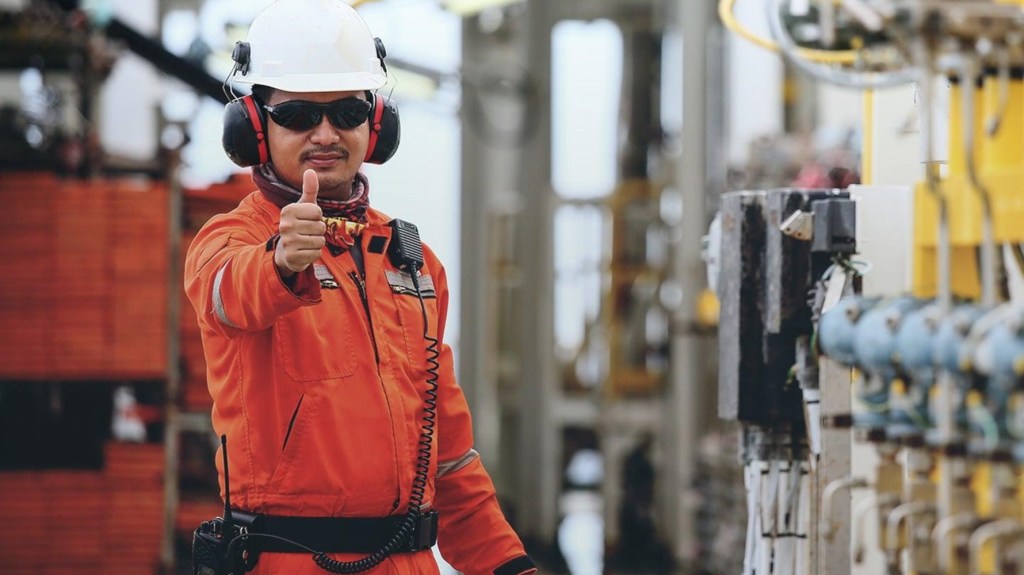
Only half of global leaders in the oil and gas sector say their companies have traveler health and safety programs in place
CWT, the B2B4E travel management platform, and its Energy, Resources and Marine (ERM) division, found through independent research that only 52% of C-suite and senior executives say their organizations have traveler health and safety programs in place. While only 32% say their organizations measure and report on the impact of traveler well-being, according to CWT ERM’s annual report, 2020 Vision: A Close Look at the Well-Being of Traveling Employees, published today.
This year’s ERM report is the first to focus primarily on the well-being of traveling employees and includes an independent global survey of nearly 400 C-suite executives and senior leaders in the oil and gas industry.
“The energy, resources and marine industries have long been leaders in understanding and addressing health and safety for their traveling workforce, not least because of the complexities ERM travelers uniquely face en route to, and when they arrive at, their often-remote destinations,” said Raphaël Pasdeloup, Senior Vice President and Global Head of CWT ERM.
“We’re going beyond just getting employees to their worksites safe and on time. We want to make sure they are rested when they get to work too,” he added. “As such, we want to encourage organizational cultures that support the well-being of traveling employees while they’re on the job, and after they’ve returned to their normal routines through monitoring and measured assessments. As our report shows, more work needs to be done in this area.”
The ‘always-on’ work culture and impact on decision-making
As work-related travel continues to rise and traveling employees are becoming more connected than ever before, the notion of always being on, regardless of the time zone, and the lack of privacy and downtime, is making travel more stressful today than in the past, the report finds. And in ERM, this could pose an immediate safety risk, where fatigue-induced decision-making, while on a rig or inside a mine, could put a worker in harm’s way.
Organizations’ top priorities when it comes to traveler well-being
Safety and risk mitigation emerged on top of an organization’s highest priorities when it comes to the health and safety of traveling employees, with concerns over productivity, health, and well-being coming close behind, according to the report.
In addition to adopting new technologies to manage issues like fatigue, jet lag, exercise and nutrition, the report also offers recommendations on building an organizational culture that supports employee well-being, including getting buy-in from leaders making travel-related decisions and defining targeted interventions to support wellness while traveling.
CWT is a leading global partner in business travel, meetings, and events. Operating across six continents, we deliver sustainable, tailored solutions that help organizations connect, engage, and thrive in an evolving world. Our myCWT platform integrates advanced technology with human expertise to simplify travel and enhance traveler and attendee experiences. Extensive global coverage, seamless data integration, AI-driven analytics, and carbon-conscious travel tools enable businesses to optimize their travel and meetings programs while delivering measurable value.
With 150 years of industry experience and a deep commitment to partnership, CWT collaborates with clients to shape the future of business travel and events, making them more efficient, responsible, and impactful.
About CWT Energy, Resources & Marine
With 40 years of experience, CWT Energy, Resources & Marine (ERM) provides specialist travel management solutions for many of the world’s leading companies in the oil & gas, mining, offshore, marine and alternative energies industries. Operating in some of the most remote and inaccessible parts of the world, as well as more mainstream locations, ERM works to make the complex easy when it comes to getting people safely and efficiently to their place of work. We facilitate the movement of thousands of travelers every day, including 900 crew rotators, across 150 countries, using innovative technology along with accurate, reliable and simple solutions from flight bookings and crew rotations, to ground transportation and accommodation. -

Come as you are: Why diversity matters
Imagine a world where there is no place for individuality. Everybody looks the same and has the same thoughts and beliefs. Scary, right?
Fortunately, the cultural diversity of our world prevents this dreadful scenario becoming real and it is a driving force of financial, intellectual, emotional, moral, and spiritual development. Its importance is crucial. In 2001 UNESCO adopted the Universal Declaration on Cultural Diversity and, the year after, the UN General Assembly declared a World Day for Cultural Diversity for Dialogue and Development. But there is still work to do.
According to the UN, three-quarters of the world’s major conflicts have a cultural dimension.
With this dreadful stat in mind, let’s campaign to increase awareness of the importance of preserving diversity and cherish our differences.
As a global company with a presence all over the world, we live and breathe diversity and actively celebrate it through global initiatives like Culture Week that rely on employee participation and anonymous feedback. It is one of our greatest differentiators.
In fact, one of our key strengths relies on the differences of our employees. Working together in a multicultural environment requires us to develop a mindset that is good for business: global thinking, openness to dialogue, combining complementary strengths, and treating each other with respect and trust.
According to Harvard Business Review, “Non-homogeneous teams are simply smarter. Working with people who are different from you may challenge your brain to overcome its stale ways of thinking and sharpen its performance.”
There is no doubt that interacting with people from different backgrounds widens your horizons, helps to banish prejudice, connect with a wide variety of customers, understand their needs and expectations and, overall, makes life interesting and rich.
Image credits: Adobe Stock
-

People first: Can you get more value from your travel spend by putting employees first?
The Japan office of a global technology company recently tested a four-day working week and found it led to happier workers and a big jump in productivity of 40 percent. They’re not the first company to trial new ways to retain a largely-Millennial workforce, who identify flexibility and well-being as top priorities when job hunting.
A move away from seeing return-on-investment from a savings and compliance perspective, to understanding the value that employees bring, is emerging more often. Savvy companies are putting their employees’ well-being at the core of their travel program.
“Maintaining healthy habits while traveling is nearing the top of the priority list for travelers around the world,” says Niklas Andreen, CWT’s Chief Traveler Experience Officer. “Being in tune with what matters to your employees is indispensable for retaining and attracting the best talent.”
So how do you make your travel program work for your staff and therefore your business?
- Different folks, different strokes – Your workforce will have differing needs from their business travel. Some want their pick of hotel rooms worthy of featuring on their Instagram grid. Others have small children at home and are attracted to family-friendly options like same-day trips. It isn’t about offering luxuries but truly understanding what individuals value and giving them personally-relevant choices.
- Always Connected – “There is a generation of people that are always connected” says Niklas Andreen, “It raises people’s stress levels not being able to connect. It has become a comfort factor. The tempo of business has sped up so much that people will send an email and expect a response within 30 minutes.” It’s critical to consider whether transport options, lounges and hotel rooms are equipped with strong connectivity.
- Tool up – Providing your employees with modern tools like a mobile app makes it easy and even enjoyable during the booking process. If you want your employees to stick to your policy, the tools and services you provide must be on par to what they use in their everyday lives.
It’s natural to want business travelers to stay within policy but some of the limitations compromise the success of their trip. Looking at ways to build your travel program around their needs will benefit your company. After all, what’s better for your people is what’s best for your business. Find more ways to build a travel program equipped for the future in the 2020 Global Travel Forecast.
Image credits: Adobe Stock
- Different folks, different strokes – Your workforce will have differing needs from their business travel. Some want their pick of hotel rooms worthy of featuring on their Instagram grid. Others have small children at home and are attracted to family-friendly options like same-day trips. It isn’t about offering luxuries but truly understanding what individuals value and giving them personally-relevant choices.
-
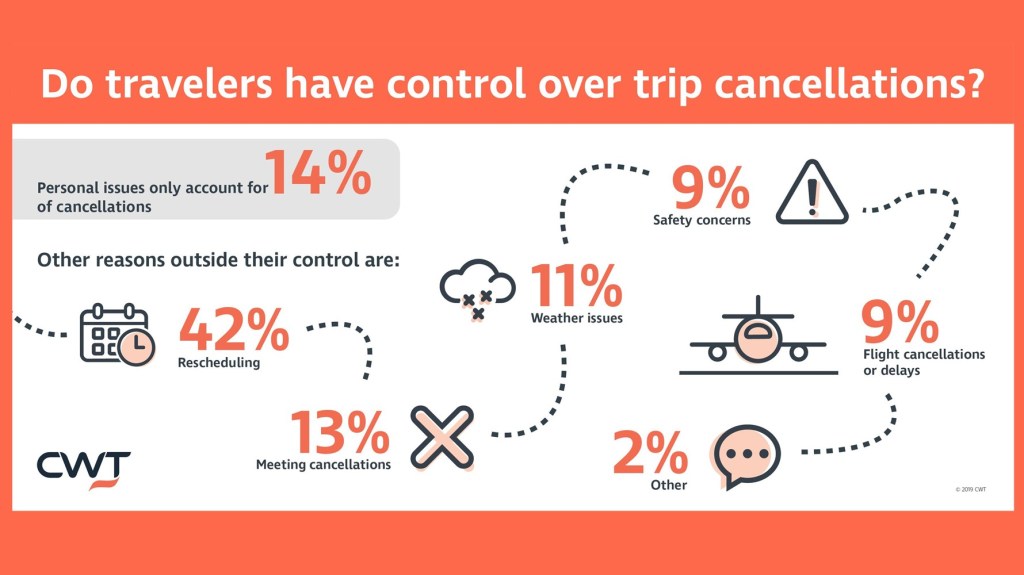
Nearly nine out of ten travelers have no control over trip cancellations
According to independent research conducted by CWT, the B2B4E travel management platform, the vast majority of business trip cancellations escape business travelers’ control. Travelers mainly abort their trips because their appointments have been rescheduled (42%). Meeting cancellations (13%), weather issues (11%), safety concerns (9%), and flight cancellations or delays (9%) are other external causes. Personal issues only account for 14% of cancellations.
“Interestingly, our survey found that 88% of trips cancelled were rescheduled for a later time,” said Amit Wurgaft, CWT’s Chief Experience Officer, Digital. “38% of which, are typically rescheduled immediately after the first trip was canceled.”
The research also shows that 68% of travelers don’t cancel all trip segments at the same time. 45% cancel flights before hotels and 22% start first with accommodation and then cancel the air segments.
Cancellation policies and possible fees
When it comes to cancellation policies and possible fees, the survey uncovers that 85% of travelers would prefer to know the fees before starting to cancel the trip or during the cancellation process.
In fact, clarity (37%) and findability (20%) of cancellation policies and fees are the main concerns for business travelers. When asked what aspects they would mainly want to improve in the cancellation process, these two factors rank top, along with reducing the time it takes to confirm everything is canceled (22%), reducing the steps needed to take to cancel a trip (10%), and having a quick way to cancel from their mobile device (10%).
About the survey
The survey was conducted online by CWT on August 2019. Responses were collected from 400 business travelers who work at large companies (>1,000 employees) with a travel policy and are directed to book travel using specific tools or designated travel agent. Respondents have traveled for business at least once in the previous 12 months and have canceled a trip in the past few months.
CWT is a leading global partner in business travel, meetings, and events. Operating across six continents, we deliver sustainable, tailored solutions that help organizations connect, engage, and thrive in an evolving world. Our myCWT platform integrates advanced technology with human expertise to simplify travel and enhance traveler and attendee experiences. Extensive global coverage, seamless data integration, AI-driven analytics, and carbon-conscious travel tools enable businesses to optimize their travel and meetings programs while delivering measurable value.
With 150 years of industry experience and a deep commitment to partnership, CWT collaborates with clients to shape the future of business travel and events, making them more efficient, responsible, and impactful.
-
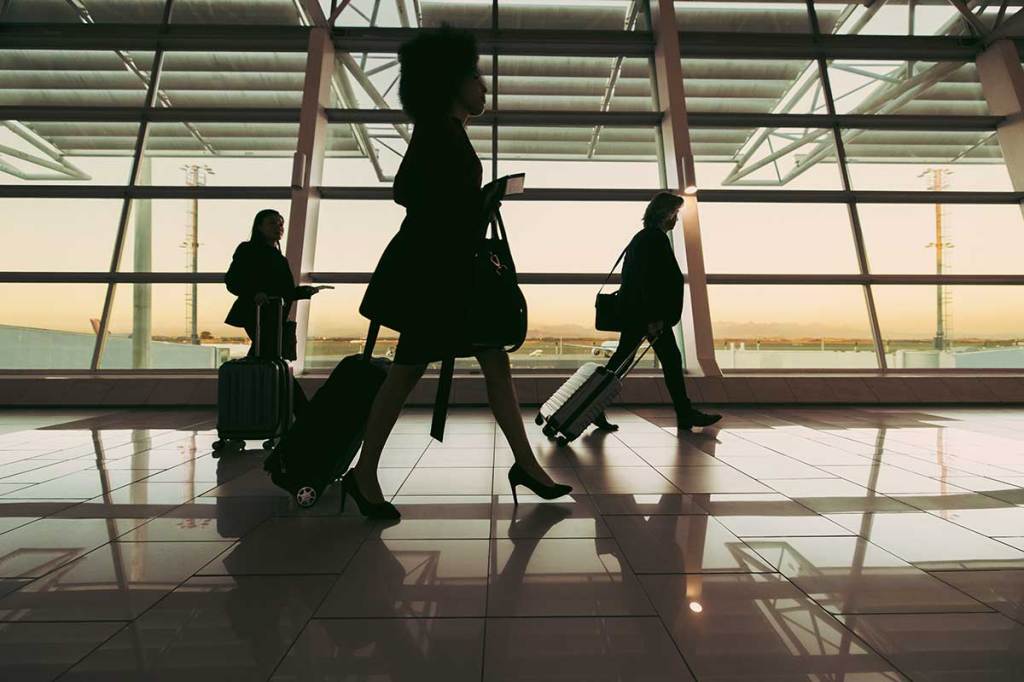
Mission Possible: 5 ways to prepare for an important work trip
Next week, from 19 – 21 November, companies from around the world will gather in Munich at Europe’s largest business travel event.
The GBTA Conference 2019 is an opportunity for organizations to showcase their latest products and services, share their insights, and get in touch with colleagues, suppliers, clients, and prospects.
CWT will be there (you can visit us at booth #50) with an agenda packed with educational sessions aimed at contributing to the advancement of our industry.
It’s thrilling to attend events like this, but there are some aspects you need to plan for to avoid last-minute surprises and beat Murphy’s Law. Let me share with you five tips that work for me.
- Contact details – You had an appointment with someone, but you got caught up with something important and you want to let her know you will be late or want to reschedule. When you try to call her, you discover that you don’t have her number… Sound familiar? Things like that happen.
Sometimes we forget to save contact details. Make sure you have everyone on speed dial for your event. That includes new contacts and people in your organization. You might need to reach out to a colleague to ask for help. - Always plugged-in – Your phone is your best friend, so make sure it is fully loaded for the show and bring a charger or an extra battery just in case. You never know. And check what plugs they use to make sure you bring an adaptor, in case they are different from the ones you use at home.
- Wi-Fi on – You should be able to access excellent Wi-Fi at the event, but let’s say for some reason it is not working when you most need it. No panic here. Your smartphone can be an excellent router for emergencies. Make sure you know how to tether it before leaving the safe-haven of your office.
- Sing little bird, sing – Help your company with social media around the event. Make sure you download your social media apps to your phone so you are ready to share what’s going on. Investigate what tags the event is using and ask your social media manager what tags your company is using.
- An extra tip for event rookies – Show your feet some love. If this is your first rodeo, don’t get carried away by vanity. We all love our fancy shoes but remember, you’ll be standing and rushing around all day. After a day or two, your feet can swell. I still remember a World Travel Market in my killer heels. It’s not a fond memory, let me tell you. And I was really young back then. The same rules apply to your outfit.
Image credits: Adobe Stock
- Contact details – You had an appointment with someone, but you got caught up with something important and you want to let her know you will be late or want to reschedule. When you try to call her, you discover that you don’t have her number… Sound familiar? Things like that happen.
-

A 6 step guide to hosting a successful responsible event
Hosting an event is part art, part science. Creating the right atmosphere for event attendees takes a huge amount of preparation and strategic thinking. And as we return to live, event planning will come with even more requirements. One of them is addressing growing concerns around climate change. With the sustainability movement gaining massive traction over the pandemic and responsible business’ advocacy on the rise, it is now more critical than ever. And the benefits are numerous for planners.
Eco-friendly events drive customer loyalty, boost morale and promote productivity in the workplace. Plus, by reducing waste and emissions, you can help the environment, strengthen your brand, and potentially save money.

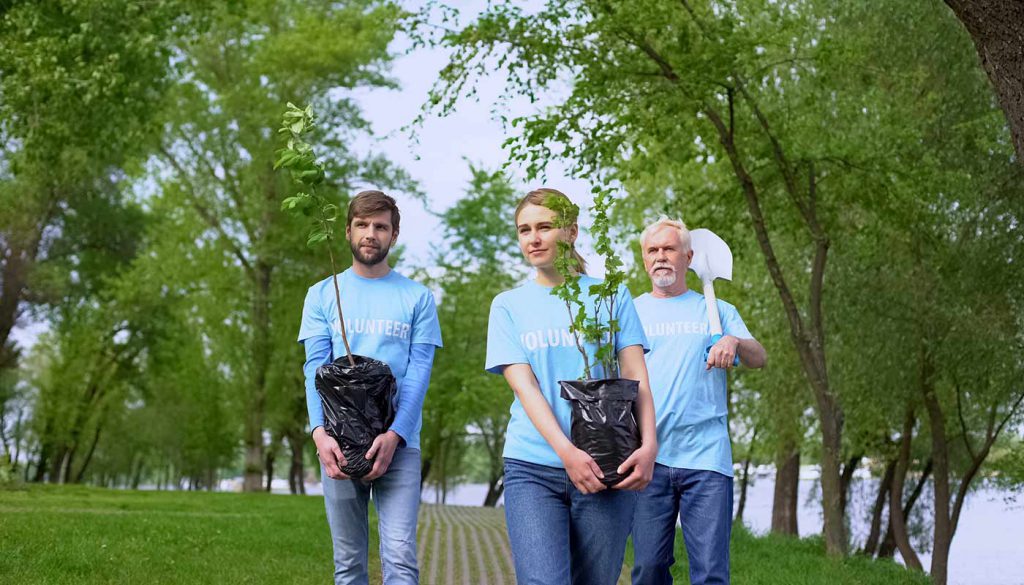
Here are 6 key steps to running a responsible and eco-friendly event:
1. Pick a sustainable destination
Travel is usually the most significant part of an event’s footprint. Selecting a destination that requires minimum travel for both attendees and hosts will reduce the need for long-distance travel and minimize your footprint. Also, consider the public transport system of each potential destination to ensure participants can reach your event easily. Is there a reliable transit system in place that can connect meeting facilities and venues? A good place to start is by looking into cities with a comprehensive sustainability program in place. For instance, the city of Bordeaux in France has acquired, through its Tourist and Congress Office, the ISO20121 eco-certification on event sustainability management.
2. Be selective about your venue
Choosing a venue that is centrally located and is easily accessible by foot or public transport is essential. If there are multiple functions within your event, try to source a venue that can accommodate, rather than choosing multiple smaller venues that require transport between them all. You can go a step further by selecting a venue that operates a comprehensive sustainability program with human rights aspects and fair labor practices. You can ask potential venues for examples of responsible practices such as waste and energy consumption, sustainability certificates, and ongoing programs to support local communities.
3. Think about transport and travel
When providing travel and local transport suggestions to attendees, recommend routes that generate less environmental impact. Travel and transportation can account for more than 90% of an event’s carbon footprint, so encourage environmentally friendly transport, or organize shared rides to the event from popular pick-up points. If flying is necessary, pick an airline with sound environmental policies. For instance, some airlines now automatically offset travel emissions.
4. Source local food and beverage
Opt for a caterer who understands the need for locally sourced, seasonal, and organic ingredients. Favor menus with vegetables and poultry over red meat, in addition to serving filtered water instead of water bottles. As a comparison, the environmental impact of bottled water is up to 3,500 times greater than filtered/tap water! And if there is leftover food, donate it to a local food bank or homeless shelter to help those in need.
5. Reduce the amount of waste produced
After more than a year of virtual events, attendees are more tech-savvy than ever and used to digital communications. So share all communications digitally and avoid printing unless necessary, or use recycled paper when needed. Goodies also aren’t always a good thing. Promotional items are too often left unused or thrown away after events. Biodegradable or reusable options are plentiful nowadays and are sure to leave a better impression on attendees.
6. Offset any unavoidable carbon emissions
To make your event carbon-neutral, offsetting emissions after your event is the easiest way to comply. Carbon offsetting is a process that allows you and your company to invest in environmental projects in developing countries to balance out your carbon footprint. And there are so many projects to invest in! Many companies are now selecting projects in line with their core competencies and values. From sustainable agriculture to better schools to protecting the rainforest – there’s always a project that is right for you.
-

Business travelers sentiment remains strong with most frequent travelers wanting even more travel
Business travelers remain optimistic and sentiment remains strong despite economic headwinds in some parts of the world.Senior-level business travelers including senior/executive management (74 percent) and directors (77 percent) agree the health of the economy is excellent, according to the second wave of research out today from the GBTA Business Traveler Sentiment Index™ in partnership with RoomIt by CWT, the hotel distribution division of CWT.
Global business traveler sentiment concerning trip experiences improved modestly over last quarter, growing 0.4 points.Growth is highest among U.S. travelers which grew 5.7 points from last quarter. This suggests growing satisfaction with the overall travel experience. Most global travelers (68 percent) say they would travel more often if given the options.
Technology is a key factor influencing business travel sentiment.The study confirms the importance of technology and shows that it also is a key area of differentiation when travelers assess their satisfaction with their business travel.
“Establishing a better traveler experience sets the foundation for increasing compliance and savings in hotel programs,” said Peggy Studer, RoomIt by CWT vice president of marketing. “Having innovative and modern technology that serves travelers relevant search results or automatically rebooks lower room rates streamlines finding and booking the right room, keeping travelers not only more productive, but overall happier.”
“With advances in travel-specific technology, travelers are more productive and willing to travel even more than they currently do” said Scott Solombrino, GBTA COO and executive director.“This bodes well for our industry and the global economy.”
Hotel Technology
Global business travelers widely use in-room hotel internet with 80 percent saying they spend an average of at least one hour per day using in-room Internet to do work, while 51 percent spent at least two hours per day using it to work.Two in five business travelers (41 percent) accessed the Internet using their own hotspot or a hotspot provided by their companies—this was especially common in Asia Pacific.
Business travelers are interested in a variety of different innovations from hotels both currently available as well as future hotel technology innovations:

CWT is a leading global partner in business travel, meetings, and events. Operating across six continents, we deliver sustainable, tailored solutions that help organizations connect, engage, and thrive in an evolving world. Our myCWT platform integrates advanced technology with human expertise to simplify travel and enhance traveler and attendee experiences. Extensive global coverage, seamless data integration, AI-driven analytics, and carbon-conscious travel tools enable businesses to optimize their travel and meetings programs while delivering measurable value.
With 150 years of industry experience and a deep commitment to partnership, CWT collaborates with clients to shape the future of business travel and events, making them more efficient, responsible, and impactful.
RoomIt by CWT
RoomIt by CWT is the hotel distribution division of CWT. Every day we match travelers with the right room at the right rate, and every minute we book over 30 hotel rooms. We also provide travelers with the amenities and loyalty programs they want, while helping organizations control their budget and improve travel oversight. -
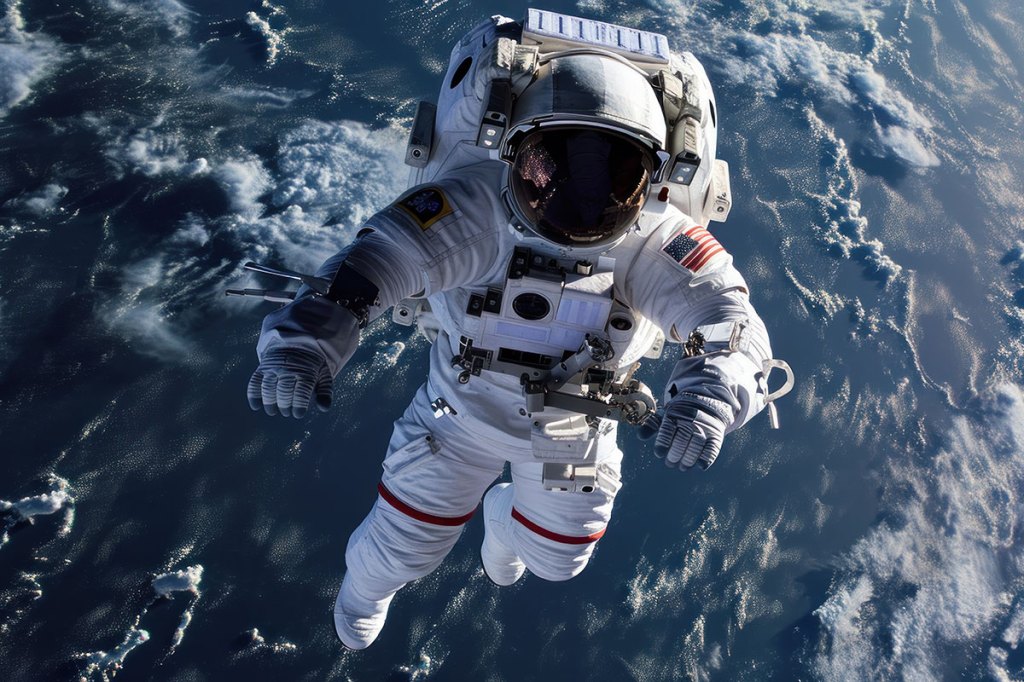
Expert tips for ERM employee wellness
Bridging the gap between employee and wellness
Hear from Dr Smith Johnston, Space Medicine Specialist, and Nicolau Chamma, Consulting Physician at International SOS, on the importance of focusing on the health of employees to maintain their wellbeing and performance at work. Enclosed is an extract of this fascinating conversation moderated by Peter Brady, Vice President Energy, Resources & Marine (ERM) | Enterprise Customers.
Image credits: Adobe Stock